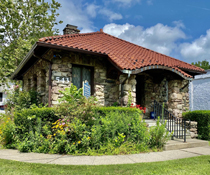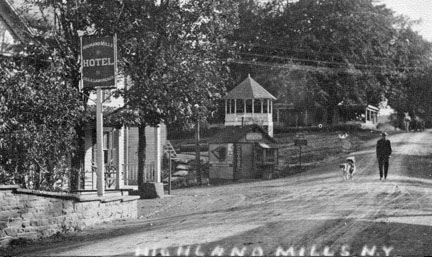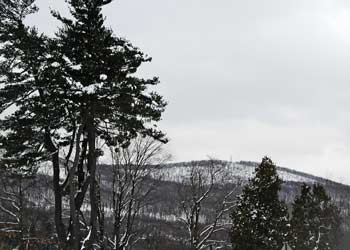

The Woodbury/ Subject Files for — Won't you consider becoming a member of the Historical Society? We can't do our work without your continued support! CLICK HERE to download the Woodbury Historical Society Membership and Donation form. Thank you! — — Woodbury The Gatehouse
|
Town History
 The Town of Woodbury, which is comprised of the hamlets of Central Valley and Highland Mills, and the area which was formerly known as the hamlet of Woodbury Falls, was officially created on December 19, 1889 by an act of the Orange County Board of Supervisors. The town’s borders meet with those of Tuxedo, Monroe, Blooming Grove, Cornwall, Highland Falls, and a short segment of Rockland County in Harriman State Park. The first town meeting was held the following year on March 4th with John A. Patterson presiding as Supervisor. The second Supervisor was James Seaman, descending from a notable lineage of Quaker farmers that lived on the northern edge of Woodbury. First delivering groceries from Woodbury Falls, the Seaman family later founded “Sweet Clover Farms” which delivered milk throughout southeast Orange County before its absorption by Poughkeepsie’s Fitchett Bros. Dairy in 1956. Most recently, the property of the Seaman family, including the C. 1796 homestead, was operated as Palaia Winery.
The Town of Woodbury, which is comprised of the hamlets of Central Valley and Highland Mills, and the area which was formerly known as the hamlet of Woodbury Falls, was officially created on December 19, 1889 by an act of the Orange County Board of Supervisors. The town’s borders meet with those of Tuxedo, Monroe, Blooming Grove, Cornwall, Highland Falls, and a short segment of Rockland County in Harriman State Park. The first town meeting was held the following year on March 4th with John A. Patterson presiding as Supervisor. The second Supervisor was James Seaman, descending from a notable lineage of Quaker farmers that lived on the northern edge of Woodbury. First delivering groceries from Woodbury Falls, the Seaman family later founded “Sweet Clover Farms” which delivered milk throughout southeast Orange County before its absorption by Poughkeepsie’s Fitchett Bros. Dairy in 1956. Most recently, the property of the Seaman family, including the C. 1796 homestead, was operated as Palaia Winery.
THE TOWN OF WOODBURY WAS CREATED TWICE
The Town of Woodbury was actually created twice - the first of these occurring in 1863 when the Board of Supervisors approved the division of Monroe into the three communities of Monroe, Tuxedo, and Woodbury. Objections to this arose and, two years later, the Legislature was asked to overrule the Board's decision and the original town boundaries were re-instated. In 1889, the Board of Supervisors once again proposed the separation and, this time, the Town of Woodbury was officially reborn.
Woodbury had gone through numerous geographic and name changes prior to its incorporation. The earliest indications of boundaries can be traced to the 1702 Chesecock Patent through which the land of approximately five Native American tribes was sold to Dr. John Bridges, Henry Ten Eyck, Derick Vandenburgh, John Cholwell, Christopher Dean, Lancaster Syms, and John Merritt. According to Russel Headley’s 1896 history of Orange County, the land under the patent was said to extend “west of Highland Mills” to “the bounds of Haverstraw and the Hudson." Until 1764, this area along with much of present-day Orange County was part of an enlarged Goshen. In that year, Goshen was divided into two parts with Woodbury becoming part of Cornwall. This was maintained through the American Revolution, with the area shown on maps as "Woodbury Clove.” At the turn of the nineteenth century, Orange County endured significant border changes with much of its southern land transformed into Rockland County and large segments of Ulster County added to its northern boundaries. In 1799, Cornwall was divided with Woodbury joining the present day Monroe and Tuxedo to become the Town of Chesekook—taking reference from the original land patent of the same name. This was later changed to Smithfields or Southfields and, in 1808, became Monroe in honor of the newly elected United States President James Monroe.
WHERE DOES "WOODBURY" COME FROM?
No one is quite sure of the origin for the name “Woodbury.” Some claim it may have come from the Dutch word “WODE" for wood as well as denoting a "dwelling place in the  woods." Others have stated that the many English families who settled here bestowed the name of a famous English family named “Woodbury" upon the area. As for the hamlets, Central Valley and Highland Mills were once called Lower Smith's Clove, with the name Smith relating to an early family of the region and the term “clove” meaning valley. Highland Mills was also known as Orange Post Office, but the residents changed it in 1824 with the present name most likely reflecting the mill and tannery businesses once located in the center of the hamlet. A map from circa 1790 shows Woodbury Falls as being called Smithfields. It may have later taken its name from the once lovely falls that bordered Route 32 underneath today’s railroad trestle. Used during the period when an iron furnace operated here, the falls were destroyed when that trestle was built between 1906 and 1909.
woods." Others have stated that the many English families who settled here bestowed the name of a famous English family named “Woodbury" upon the area. As for the hamlets, Central Valley and Highland Mills were once called Lower Smith's Clove, with the name Smith relating to an early family of the region and the term “clove” meaning valley. Highland Mills was also known as Orange Post Office, but the residents changed it in 1824 with the present name most likely reflecting the mill and tannery businesses once located in the center of the hamlet. A map from circa 1790 shows Woodbury Falls as being called Smithfields. It may have later taken its name from the once lovely falls that bordered Route 32 underneath today’s railroad trestle. Used during the period when an iron furnace operated here, the falls were destroyed when that trestle was built between 1906 and 1909.
NINETEENTH CENTURY EXPANSION
Apart from the discussed flour and grist mills once located off today’s County Route 105 in Highland Mills, as well as the Woodbury Furnace of Woodbury Falls, the town’s industry remained quiet until the arrival of the railroad to Orange County. In 1841, the New York & Erie Railroad began operating service between Piermont and Goshen, though the mainline missed Woodbury by just a few miles-instead serving nearby Turner’s (today known as Harriman) as well as Monroe. It would take twenty-eight years before each of Woodbury’s three hamlets received railroad stations in 1869 and, in the decades following, industry flourished. Among the most prominent industry located in Woodbury was the production of fly fishing rods and line, with three individuals calling this town home. Central Valley was home to Hiram L. Leonard’s nationally-acclaimed rod works off today’s Laura Lane while the Hall Line Factory and E. F. Payne’s rod works were located a few thousand feet apart in Highland Mills. Today, the mammoth Hall Line factory that once stood along Park Avenue no longer exists though the Payne rod workshop still stands at the corner of Hollis and Elm streets, as does the second Leonard Rod facility in Highland Mills.
Complimenting manufacturing after the coming of the railroad was the growth of tourism in Woodbury after 1869. By the turn of the twentieth century, the town boasted over twenty hotels as well as numerous boarding houses. Two of the largest, the Mountaintop and Summit Lake Houses once standing near the junction of Routes 6 and 293, boasted electric lighting and telephones. Highland Mills’s Cromwell Lake was itself a resort destination, with accommodations like Hillcrest and the Cromwell Lake House being able to accommodate over one handed guests each. As the twentieth century progressed, Woodbury also became home to numerous Jewish summer bungalow colonies. The largest of the colonies, Unser Camp/Kinderwelt, boasted a lengthy list of influential guests including Nobel Prize-winning physicist Leon Lederman, Academy Award-winning director Sidney Lumet, and cinematographer Jerome Robbins. Today, the site of Unser Camp is now occupied by Highland Lakes estates. Likewise, few pieces of evidence surrounding Woodbury’s hotel industry remain. With none of the turn-of-the-century hotels remaining, only a few boarding houses still stand while one bungalow colony, Raananah Park, remains operational.
GATEWAY TO ORANGE COUNTY—PAST AND PRESENT
While its tourism industry has shifted perspectives, the beauty of the Town of Woodbury remains as pleasing to the eye as it did a century ago. Bordered by Schunnemunk Mountain to the northwest and the Hudson Highlands to the southeast, the Woodbury Creek meanders tranquilly through the three hamlets. However, even though Woodbury remains a bedroom community, it is no longer the “countryside” as it was once advertised one hundred years ago. Often known as the “Gateway to Orange County,” Woodbury is located at the intersection of Routes 6, 32, 17 (The Quickway/Interstate 86), and the New York State Thruway (Interstate 87). These four roads converse between exit 16 on the Thruway and exits 131/130A on the Quickway, which underwent a complete redesign between 2018 and 2020 to accommodate the region’s growing traffic. Located approximately 45 miles north of New York City, Woodbury is a natural commuter hub with many town residents working in the metropolis.
The largest employer and tourist attraction in the town, as well as one of the state’s top tourist destinations, is the Woodbury Common Premium Outlet Center located in Central Valley, just to the northwest of exit 16 on the Thruway. Originally home to farms as well as the original alignment of the state road, the first stores opened in 1985 and have steadily expanded since to include a four-story parking garage and an impressive indoor food court. As of 2019, the mall’s 250 stores attracted more than 13 million visitors annually.
Just as Woodbury proves to be  attractive for tourists today, the same scenery enticed distinguished individuals to dwell here centuries prior. Among the list of Woodbury’s distinguished residents include attorney Charles E. Rushmore for whom Mount Rushmore is named, burlesque entertainer Gypsy Rose Lee, business manager Armand Hammer, and Ethan Dodds who held more patents than Thomas Edison. One of the society’s committees, the Gatehouse Committee, oversees the historic gatehouse that acted as the entrance for vaudeville pioneer Frederick Freeman Proctor’s estate. Woodbury’s largest estate, Arden House, was built between 1904 and 1912 for railroad magnate Edward Henry Harriman—father of New York State governor Averell Harriman. The mansion even featured a private incline railway up the side of tower hill, which was removed in 1941. After decades of ownership by Columbia University, Arden House is now owned privately.
attractive for tourists today, the same scenery enticed distinguished individuals to dwell here centuries prior. Among the list of Woodbury’s distinguished residents include attorney Charles E. Rushmore for whom Mount Rushmore is named, burlesque entertainer Gypsy Rose Lee, business manager Armand Hammer, and Ethan Dodds who held more patents than Thomas Edison. One of the society’s committees, the Gatehouse Committee, oversees the historic gatehouse that acted as the entrance for vaudeville pioneer Frederick Freeman Proctor’s estate. Woodbury’s largest estate, Arden House, was built between 1904 and 1912 for railroad magnate Edward Henry Harriman—father of New York State governor Averell Harriman. The mansion even featured a private incline railway up the side of tower hill, which was removed in 1941. After decades of ownership by Columbia University, Arden House is now owned privately.
| © Woodbury Historical Society | All rights reserved. Designed and maintained by e-Diner Design & Marketing, Inc. |
